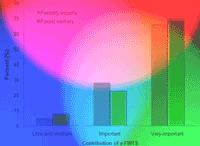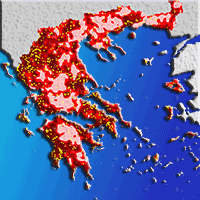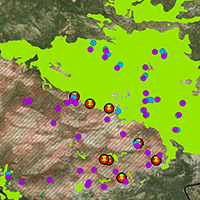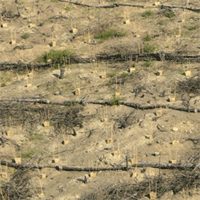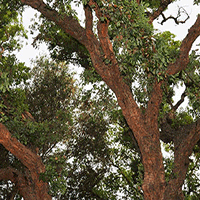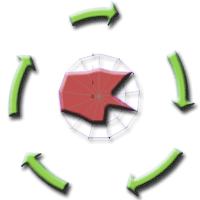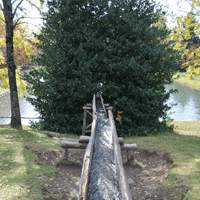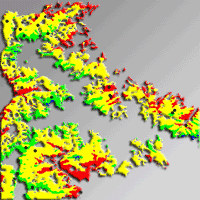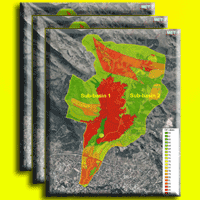
The impacts of a wildfire on hunting demand: a case study of a Mediterranean ecosystem
Konstantinos G Papaspyropoulos (1) , Christos K Sokos (2), Periklis K Birtsas (3)
iForest - Biogeosciences and Forestry, Volume 8, Issue 1, Pages 95-100 (2015)
doi: https://doi.org/10.3832/ifor0799-007
Published: May 12, 2014 - Copyright © 2015 SISEF
Research Articles
Abstract
The present study attempted to estimate the socioeconomic impacts on hunting demand caused by a 2006 wildfire on a typical Mediterranean ecosystem in Greece (Kassandra peninsula). A questionnaire administered to a sample of local hunters was used to test the hypothesis that the wildfire and the consequent hunting ban, which was used by the Greek Forest Service as a measure for wildlife protection, posed a significant impact on the demand of hunters for hunting licenses and hunting trips. Using questionnaires as a source of information it was assessed what these impacts meant for the economy, either on local, or national scale, by estimating the income elasticity of demand for hunting licenses in the area of Kassandra and the expenses for hunting excursions before and after wildfire. It was observed that hunters attempted to preserve their activity despite the excessive hunting restrictions. Implications for hunting management and policy decision making were examined.
Keywords
Elasticity of Demand, Hunters, Hunting Management, Wildfires, Greece
Authors’ Info
Authors’ address
Laboratory of Forest Economics, Faculty of Forestry and Natural Environment, Aristotle University of Thessaloniki, GR-54124 Thessaloniki (Greece)
Research Division, Hunting Federation of Macedonia and Thrace, Ethnikis Antistaseos 173-175, GR-55134 Thessaloniki (Greece)
Laboratory of Wildlife, Department of Forestry and Management of Natural Environment, Technological Educational Institute of Thessaly, Mavromichali str., GR-43100 Karditsa (Greece)
Corresponding author
Paper Info
Citation
Papaspyropoulos KG, Sokos CK, Birtsas PK (2015). The impacts of a wildfire on hunting demand: a case study of a Mediterranean ecosystem. iForest 8: 95-100. - doi: 10.3832/ifor0799-007
Academic Editor
Francesco Ripullone
Paper history
Received: Sep 25, 2012
Accepted: Oct 28, 2013
First online: May 12, 2014
Publication Date: Feb 02, 2015
Publication Time: 6.53 months
Copyright Information
© SISEF - The Italian Society of Silviculture and Forest Ecology 2015
Open Access
This article is distributed under the terms of the Creative Commons Attribution-Non Commercial 4.0 International (https://creativecommons.org/licenses/by-nc/4.0/), which permits unrestricted use, distribution, and reproduction in any medium, provided you give appropriate credit to the original author(s) and the source, provide a link to the Creative Commons license, and indicate if changes were made.
Web Metrics
Breakdown by View Type
Article Usage
Total Article Views: 51023
(from publication date up to now)
Breakdown by View Type
HTML Page Views: 43103
Abstract Page Views: 2728
PDF Downloads: 3845
Citation/Reference Downloads: 23
XML Downloads: 1324
Web Metrics
Days since publication: 4230
Overall contacts: 51023
Avg. contacts per week: 84.44
Citation Metrics
Article Citations
Article citations are based on data periodically collected from the Clarivate Web of Science web site
(last update: Mar 2025)
(No citations were found up to date. Please come back later)
Publication Metrics
by Dimensions ©
Articles citing this article
List of the papers citing this article based on CrossRef Cited-by.
References
Biology and wildlife of the Mediterranean region. Oxford University Press, Oxford, UK, pp. 350.
Gscholar
Essential statistics for economics, business and management. John Wiley and Sons, Chichester, UK, pp. 653.
Gscholar
IBM SPSS 19 Statistics made simple. Psychology Press, East Sussex, UK, pp. 688.
Gscholar
Revcad - Journal of Geodesy and Cadastre 10: 99-112.
Gscholar
Testing for differential effects of forest fires on hiking and mountain biking demand and benefits. Journal of Agricultural and Resource Economics 26 (2): 508-522.
Gscholar
Investigator-based interviews. International Journal of Market Research 46 (1): 99-102.
Gscholar
Macroeconomics: principles, problems, and policies (19th edn). McGraw-Hill/Irwin, New York, pp. 581.
Gscholar
Reconciling gamebird hunting and biodiversity (REGHAB). Socio-economic aspects of gamebird hunting, hunting bags, and assessment of the status of gamebird populations in REGHAB countries. Part 1. Socioeconomic and cultural aspects of gamebird hunting. REGHAB, London, UK, pp. 52.
Gscholar
Landscape - wildfire interactions in southern Europe: implications for landscape management. Journal of Environmental Management 92 (10): 2389-2402.
CrossRef | Gscholar
Sustainability of recreational hunting tourism: a cluster analysis approach for woodcock hunting in Greece. In: “New Trends towards Mediterranean Tourism Sustainability” (Rosalino LM, Silva A, Abreu A eds). NOVA Publishing, New York, USA, pp. 79-94.
Gscholar
Animals, fire, and vertebrate herbivory in Californian chaparral and other Mediterranean-type ecosystems. In: “The Role of Fire in Mediterranean-Type Ecosystems” (Moreno JM, Oechel WC eds). Springer-Verlag, New York, USA, pp. 46-78.
Gscholar
A typology of family forest owners in north central Indiana. Northern Journal of Applied Forestry 24 (4): 282-289.
Gscholar
Multi-methodical approach for the influence of forest fire on hare (Lepus europaeus) at Kassandra, Chalkidiki, Hellas. MSc dissertation, Department of Forestry and Environmental Management and Natural Resources, Democritus University of Thrace, Komotini, Greece, pp. 76. [in Greek]
Gscholar
Hunting management and hunting - related values. In: Proceedings of “2nd conference on environmental management, engineering, planning and economics (CEMEPE)” (Kungolos A, Aravossis K, Karagiannidis A, Samaras P eds). University of Thessaly and National Technical University of Athens, Greece, pp. 1-4.
Online | Gscholar
Global vegetation-fire pattern under different land use and climate conditions. In: Proceedings of the “AGU Fall Meeting 2008”. San Francisco (CA, USA) 15-19 Dec 2008. American Geophysical Union, Washington, DC, USA, abstract #B42B-02.
Online | Gscholar

